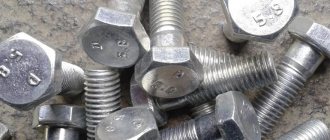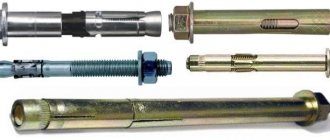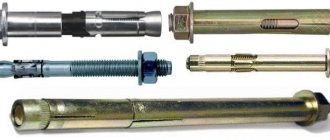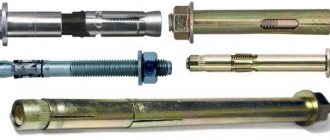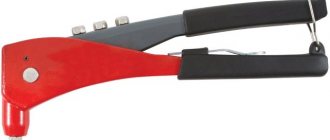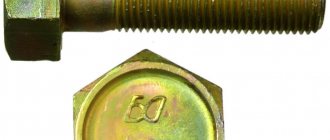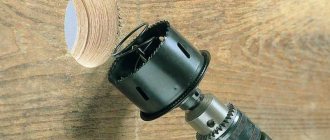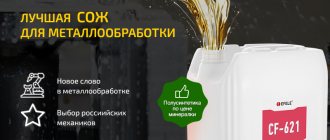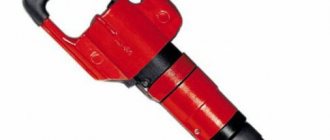Bolt components
Bolts are fasteners that consist of two parts: a threaded leg and a head that connects to the leg through a hole. Typically, these fasteners are made from high quality carbon steel. Depending on the manufacturing technology, bolts can be galvanized or non-galvanized.
The advantages of galvanized fasteners are that they are more resistant to corrosion and do not lose their metallic luster throughout their entire service life. Mostly such bolts are used in visible places where parts are connected, for example: during the assembly of furniture, various equipment, external cladding, as well as in interior furniture.
In addition, bolts can also be made of heat-resistant, stainless steel, but bolts are practically not made of copper or brass. Bolts are manufactured in accordance with GOST and DIN recommendations.
Nuts, washers and screws
These three hardware can be classified in one section, since they belong to the category of fixing ones and do not work as separate fasteners. Let's start with the simplest element - the washer. This is a round product that is attached to a bolt and installed under the nut. The washer prevents the nut from unscrewing and in some cases closes the empty space if the hole into which the bolt is inserted is larger than the diameter of the bolt itself. Washers, despite their simplicity, may differ in the material from which they are made. The most common nuts are made of metal, but there are also rubber and plastic elements. They are used when fastening products that require careful handling of the surface. For example, painted corrugated sheeting is screwed through a rubber washer. It provides a tight connection, but unlike metal, it is not capable of harming the painted surface.
Grover is one of the types of fastening washer. This is a metal ring, sawn on one side and bent in a spiral. When tightened with a nut, the ring takes its original shape, thereby creating tension, that is, providing better clamping. Grovers are made of a stronger grade of steel, and after unwinding they bend again, which allows them to be used repeatedly. The purpose of the Grover is to prevent unwinding, that is, the same as a regular washer. But the grower, due to its shape, can work under heavy load and provides a reliable connection during vibration. Grovers are used in mechanical engineering and on various machines, that is, wherever vibration is present. If you tighten the nut without a screwdriver, it will simply come loose over time.
Nuts are the most diverse hardware in this category. They serve to fix threaded fasteners, that is, they are screwed onto a bolt or screw. In addition to the size and thread pitch, the nuts differ in shape, and the list of configurations is quite large:
- Straight hex nuts. The most common type of hardware, found most often.
- Crowned. It has grooves on the top into which, after tightening, a special cotter pin is inserted to prevent unwinding.
- Lamb. A nut with special protrusions that allow it to be tightened without using a wrench. Used for fastening objects that do not experience heavy loads and with minimal vibration.
- Square. A special nut inserted into a special groove. It does not need to be held with a key when tightening, since it is already fixed in the mounting hole.
- Flanged. The lower part of the nut has a skirt with notches. When twisted, it provides a more reliable grip on the puck or groover.
This is not a complete list of nut form factors, and many modern equipment manufacturers use their own designs, as is the case with the shape of screws and screws.
According to the shape of the hat
Depending on the shape of the head and purpose, the following hardware is distinguished. The most commonly produced bolts have a hexagonal or round head, but they are also found with oval and square ones. In addition, the caps also differ in head size. So, according to DIN standards, there are such fasteners that have standard, reduced and enlarged profiles.
The shape of the head itself can also be of three types: flat, convex and hidden. The last form of head is the hidden one, which is used in furniture assembly. Sometimes during renovations, many people use bolts with a hidden head so that they do not spoil the aesthetic appearance of the room.
• on the first and second there is a hexagon-shaped cap;
• the third and fourth shows the shape of the head with turnkey flats;
• on the fifth, the bolt head has an internal hexagon;
• the sixth picture shows a hat with triangular slots;
• the seventh shows the hidden location of the bolt with internal hexagons.
Types and types of anchors and methods of their fastening
Anchoring for concrete structures can be very diverse, using a single or multiple influencing forces - support, a molecular link in the stage of adhesion, friction, fracture, contraction, etc.
According to their intended purpose, the types of anchor bolts for concrete structures are made: frame, ceiling, support and multifunctional. According to the configuration - curved and straight, with an installation or integral system. The type of anchor can be wavy or smooth.
According to the assembly method, a foundation bolt can be through fastening, wedging, driving in, screwing in, etc.
Significant meaning is contained in the substance from which the product is made. In the case of steel, the strength level is 6.8 or higher, treated with an anti-corrosion agent, then it will withstand much longer. Brass will not withstand severe vertical stresses.
Spacers
Expansion anchors for building concrete are often used with nuts; Ftr works in this method. They look like a not very large rod with a thread, a sleeve-shaped cap and a cone.
If the fastener is screwed into the foundation, it spreads out and holds the element firmly in the concrete block.
Spacer anchors installed in walls will not be able to be used next time.
Spacer anchors are also sleeve and sleeve anchors. Used for dense foundations of concrete structures. A small contact zone sometimes with a small caliber model provides an option to withstand significant overloads.
The anchor bolt with nut can be electro-galvanized, hot-dip galvanized, and has acid-resistant properties. This includes helical anchors made of stainless steel.
Drivers
Drive-in anchors are selected for strong concrete.
The foundation bolt is mounted using this type of pins - when assembling boxes, upper air intakes, and placing technical equipment.
Before driving the staple into the stone wall, first drill a suitable hole. Later, the metal product is hammered in, the rim is pulled apart, and a threaded rod of the required length is screwed in. A similar foundation bolt touches the dowel rod and the upper (on the ceiling) anchor.
It is practical to strengthen Armstrong suspensions, supports, and ceilings on them. Typically, the fastening element is used as a fire safety element or against vandalism, since the pin is permanent and cannot be removed.
Frame
They are used to separate openings where window and door frames are installed. The quill is made with a cut along the length; a small release coupling during tightening effectively supports the opening of the system, passing to a suitable place.
In order to protect it from displacement and screwing near its point, there are accents at the top of the quill.
Self-tapping screws for concrete
Here, the strength of the installation occurs through a thread made along the entire length of the pin. During the stage of screwing into a concrete support, a massive resistance to tearing off or displacing the mechanism is formed. When using such a fastener sample, the load-bearing capacity is quite large (up to 100 kg).
Expanding
Can be used to secure cornices, shelving, light sources, canvases and other objects into hollow structures with low load-bearing capacity. The clamp on the screw or pin is designed as a diverging skirt; when the pin is screwed into the foundation, it sticks into the inside of the base.
Along the outer part of the clamp, special needles are immersed in wood concrete to prevent the pin from moving or turning during assembly.
Chemical anchor
This concrete anchor bolt is a semi-liquid part and hardens easily. It is with this part that the pin is wedged into the block of concrete. In view of this composition, it is possible to guarantee a strong adhesion of the base and the pin with a uniform load order along the full length of the fastening material.
Chem. anchors for a building monolith do not induce hidden loads, significantly reducing the risk of collapse and destruction.
By type of bolt leg
Generally, bolt legs are manufactured to a standard diameter across the entire shank. But there are also bolts on sale with a stepped leg, where the threaded part is already smooth. This shape of the bolt helps balance the load, which is why this type of fastener is used to connect very heavy parts. Thus, the following types of bolt are distinguished:
• with standard rods
• carriage bolt
• with a sealed foot for installation in the hole without gaps
• with a leg of a smaller diameter smooth part
How to properly tighten and loosen a bolt
Most often, when tightening bolted connections on various structures in the household, ordinary wrenches are used - socket, open-end and box-end wrenches. However, in this case, it is difficult to accurately determine the tightening torque, so in industrial production and repair shops, experienced mechanics use special torque wrenches or pneumatic impact wrenches, the main advantage of which is the ability to set the required tightening level, depending on the type of mechanism.
To unscrew the bolt, the same keys are used, however, in old designs, most often the bolts “stick” strongly to the nut due to corrosion. For safe unscrewing, several simple methods are used:
- use of aerosol-type penetrating lubricant WD-40;
- lightly tapping the rusty bolt with a hammer to destroy the rust in the profile of the threaded connection;
- Turn the nut slightly in the direction of tightening (just a few degrees).
The first digit indicates 1/100 of the nominal tensile strength, measured in MPa. In the case of 8.8, the first 8 means 8 x 100 = 800 MPa = 800 N/mm2 = 80 kgf/mm2 The second number is the ratio of the yield strength to the tensile strength multiplied by 10. From a pair of numbers you can find out the yield strength of the material 8 x 8 x 10 = 640 N/mm2
The yield strength value is of practical importance because it is the maximum working load of the bolt.
Tensile strength is the magnitude of the load, when exceeded, destruction occurs - “the greatest breaking stress.”
Yield strength is the magnitude of the load, when exceeded, irreversible deformation or bending occurs.
The percentage of elongation is the average amount of elongation of a deformable part before it breaks or ruptures. The technical term is “relative elongation” which shows the relative (percentage) increase in the length of the sample after rupture to its original length.
The most important classification feature of bolts, screws, studs and nuts is strength. In addition to size, it depends on the material of these parts and on heat treatment. For steel bolts, screws and studs, GOST 1759-70 establishes 12 strength classes - 3.6; 4.6; 4.8; 5.6; 5.8; 6.6; 6.8; 6.9; 8.8; 10.9; 12.9; 14.9. The first number shows the tensile strength of the material in kgf/mm, reduced by ten times for convenience of designation. The second number is the ratio of the material’s yield strength to its tensile strength, multiplied by 10 for convenience. For example, the strength class of a bolt is 5.8. Consequently, the tensile strength of its material is 50 kgf/mm2, the ratio of the yield strength to the ultimate strength is 0.8. Steel nuts have seven strength classes: 4; 5; 6; 8; 10; 12; 14. These numbers represent the voltage from the test load divided by 10.
Areas of use
Bolts are used for fixation in detachable structures. If necessary, bolt-type fasteners can be disassembled. The connection with the bolt is static and rigid. The main area of use of bolts is the construction of load-bearing structures: car frames, machine beds, building frames.
Screws create a movable connection, which affects the area of their use. They are used in watch mechanisms and lathes. Self-tapping screws are used as fasteners to hold light weight objects (shelves, pictures, lamps).
Let's summarize. How does a bolt differ from a screw by definition and scope of use:
- In a bolted connection, the load is distributed perpendicular to the direction of the hole, in a screw connection - parallel to it.
- The threads in the screws are cut along the entire length of the stud; the bolt has a thickening between the head and the thread on the stud.
- A bolt is used with a nut, a screw - without it.
- Bolted fasteners are often large in size, unlike screw fasteners.
- Bolts are used in connections where it is necessary to withstand high loads.
- The head of the screw must have a slot for a screwdriver; the head of the bolt does not have such a slot.
What is the difference between a screw and a bolt and a screw: comparison, photo
A screw differs from a screw and bolt in that it has a thinner thread and a pointed tip. Used without nut and washer. Most often, its surface is self-tapping, that is, when a certain force is applied, the self-tapping screw can be screwed into a wooden surface, without cutting a preliminary thread. Screws and bolts are not used for these purposes because they do not have a pointed tip and do not have a self-tapping characteristic.
Plumbing screw
Bolt
Screws
Materials for the manufacture of fasteners
Although fastener elements are made not only from metals, but also from plastics, wood and other materials, the main interest is in fasteners made from various types of steels, non-ferrous metals and alloys. Due to the high cost of the latter, the bulk of the fasteners produced are made from various grades of steel. The selected material depends on the requirements for the mechanical and physical-chemical characteristics of fasteners and is determined by the table below:
| Fastener steel grade | tensile strength σв, MPa | yield strength σt, MPa | relative elongation σ5, % | impact strength, aH, J/cm2 | |
| Bolts | Nuts | no less | |||
| 12Х18Н10Т | 12Х18Н9Т, 10Х17Н13М2Т | 520 | 200 | 40 | 40 |
| 20Х13 | — | 700 | 550 | 15 | 60 |
| 14Х17Н2 | 20Х13, 14Х17Н2 | 650 | 12 | 60 | |
| 10Х11Н23Т3МР 13Х11Н2В2МФ | — Х12Н22Т3МР | 900 | 550 | 8 | 30 |
| 25Х1МФ | 25Х2М1Ф 20Х1М1Ф1ТР | 750 | 10 | 30 | |
The choice is determined by the requirements for corrosion resistance, temperature strength, ability to work under pressure, in aggressive environments, the presence or absence of certain magnetic properties, etc.
In a number of cases, when high demands are placed on fastening elements in terms of corrosion resistance, weight, strength, dimensions, high heat resistance, lack of spark upon impact, and many others, other metals and alloys are used for their manufacture. We are talking about brass, titanium, tantalum, beryllium alloys, aluminum, tungsten and others.
How to choose the right one
Screws can be purchased to assemble a structure or replace items that are already fairly worn out or have become unusable, for example, under the influence of increased external loads. Operating conditions should also be taken into account:
- requirements for the level of reliability of the formed connection;
- degree of protection of the fastening unit;
- type of loads - static or dynamic;
- installation location - outdoors or indoors.
If you need to fasten a metal frame or thin plates/sheets, it is recommended to use screws with a hemispherical head and a press washer. Confirmats are used to assemble cabinet furniture items. The tie (this is another name for such a screw) is a reliable and durable product. Before installing it, it is necessary, along with drilling the hole, to prepare a seat for the head of the flush-mounted clamp.
The need for a cap screw arises when fastening a sheet of metal to a structure made of the same material. The appearance of this product is very aesthetic.
It is customary to connect thickened sheet material to a metal frame using a screw with a countersunk head. Here, too, its installation is preceded by a number of actions. First, you need to drill a hole. Secondly, remove the chamfer in such a way that the outer end plane of the head is located, after screwing in the fastener, at the same level as the surface of the plate. The attractive appearance of the connection formed in this way is offset by poor resistance to dynamic loads.
Protective coatings for fasteners
Fastening elements are additionally protected by creating oxide films (oxidation), as well as various types of coatings. The choice of coating is determined by technical requirements; the thickness depends on the size of the fastener and the thread pitch. In particular, for the most popular options:
- With a thread pitch P < 0.4 mm, the coating thickness varies in the range of 3-6 µm;
- With a thread pitch of 0.4 < P < 0.8 mm, the thickness is 6-9 µm;
- With a thread pitch of P > 0.8 mm, the coating thickness is 9-12 microns.
All necessary definitions are contained in GOST 1759.4-87. Coatings must meet the requirements specified in Table 2:
| Designation | Coating | Operating temperature, t °C, no more |
| 00 | Uncoated fasteners | |
| 01 | Chromated zinc plated fasteners | 300 |
| 02 | Cadmium plated with chromated fasteners | 200 |
| 03 | Multi-layer copper-nickel coating of fasteners | 600 |
| 04 | Multilayer copper-nickel-chrome | 600 |
| 05 | Oxide coating of fasteners | 200 |
| 06 | Phosphate oil-coated coating of fasteners | 200 |
| 07 | Tin plated fasteners | 150 |
| 08 | Copper plating fasteners | 600 |
| 09 | Zinc coating of fasteners (galvanized fasteners) | 200 |
| 10 | Oxide anodizing coating of fasteners with chromate plating | 200 |
| 11 | Oxide coating of fasteners made from acidic solutions | 200 |
| 12 | Silver plated fasteners | 600 |
| 13 | Nickel plated fasteners | 900 |
